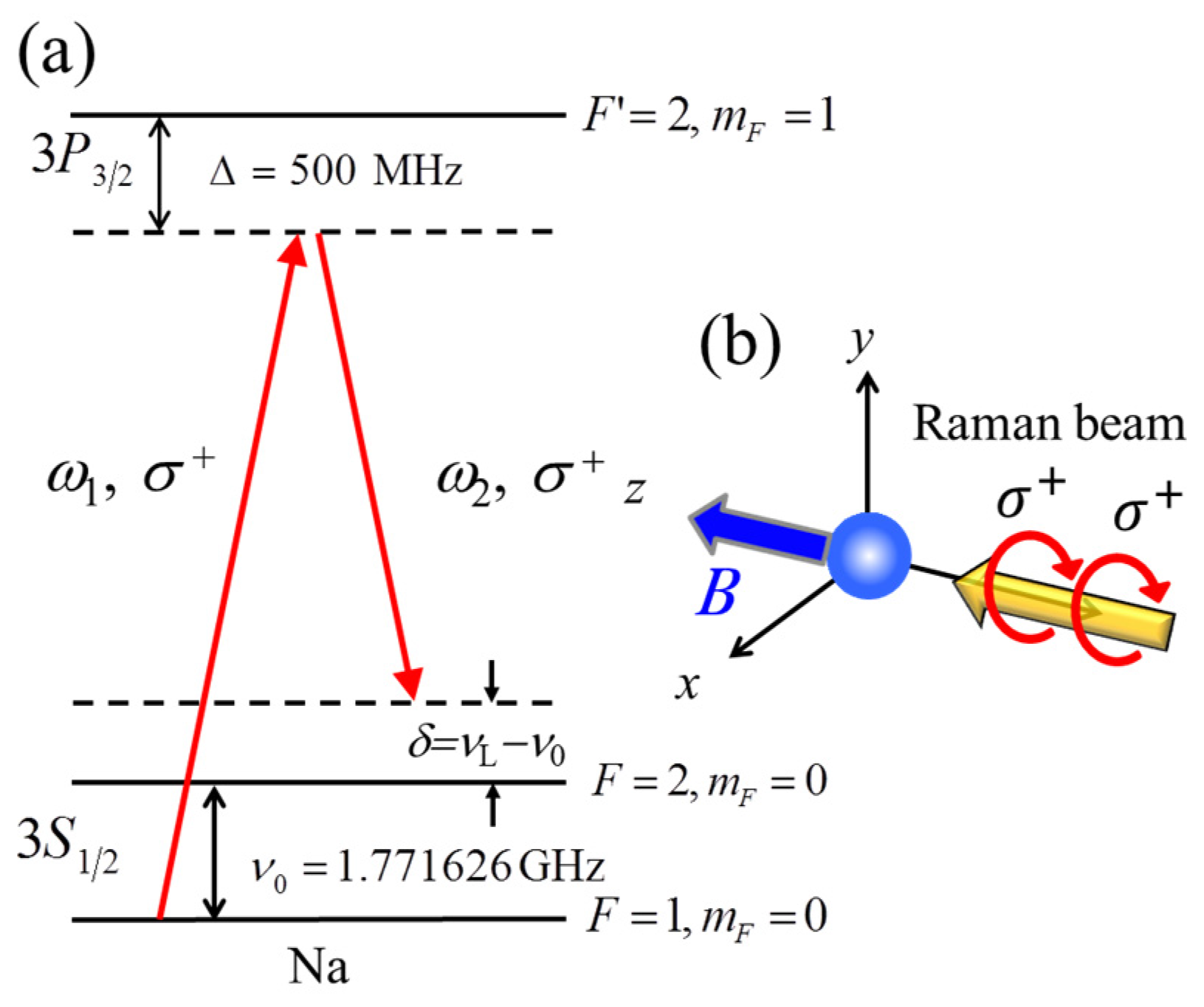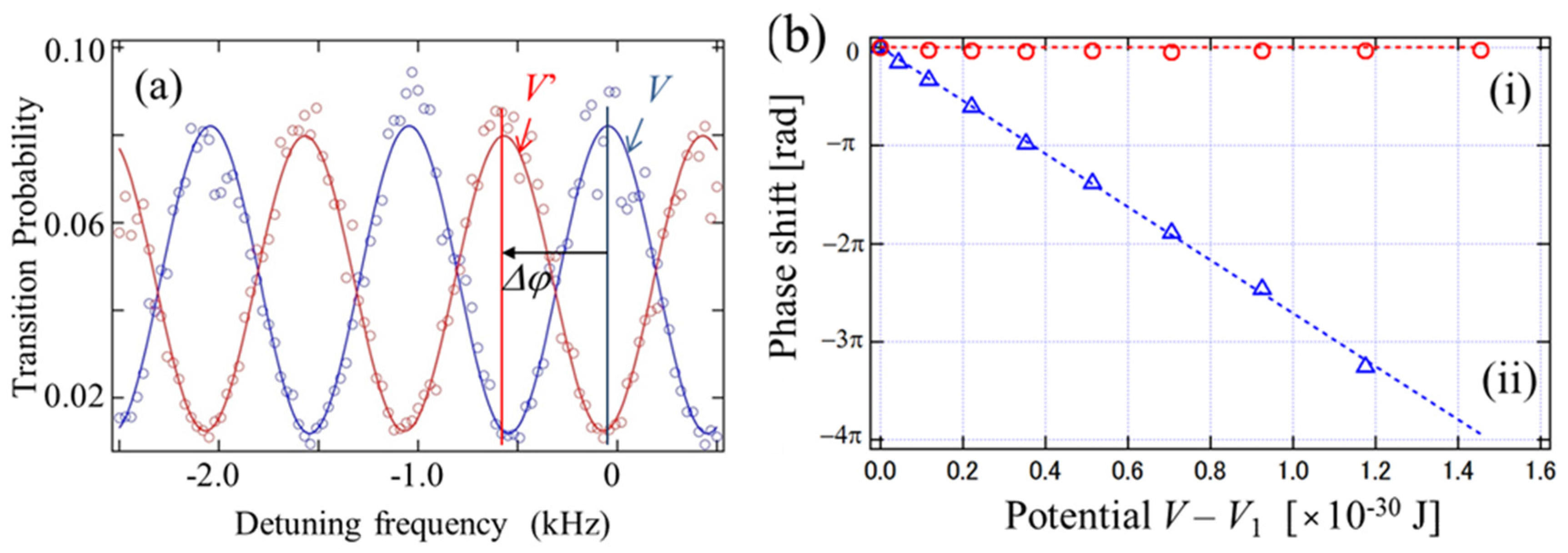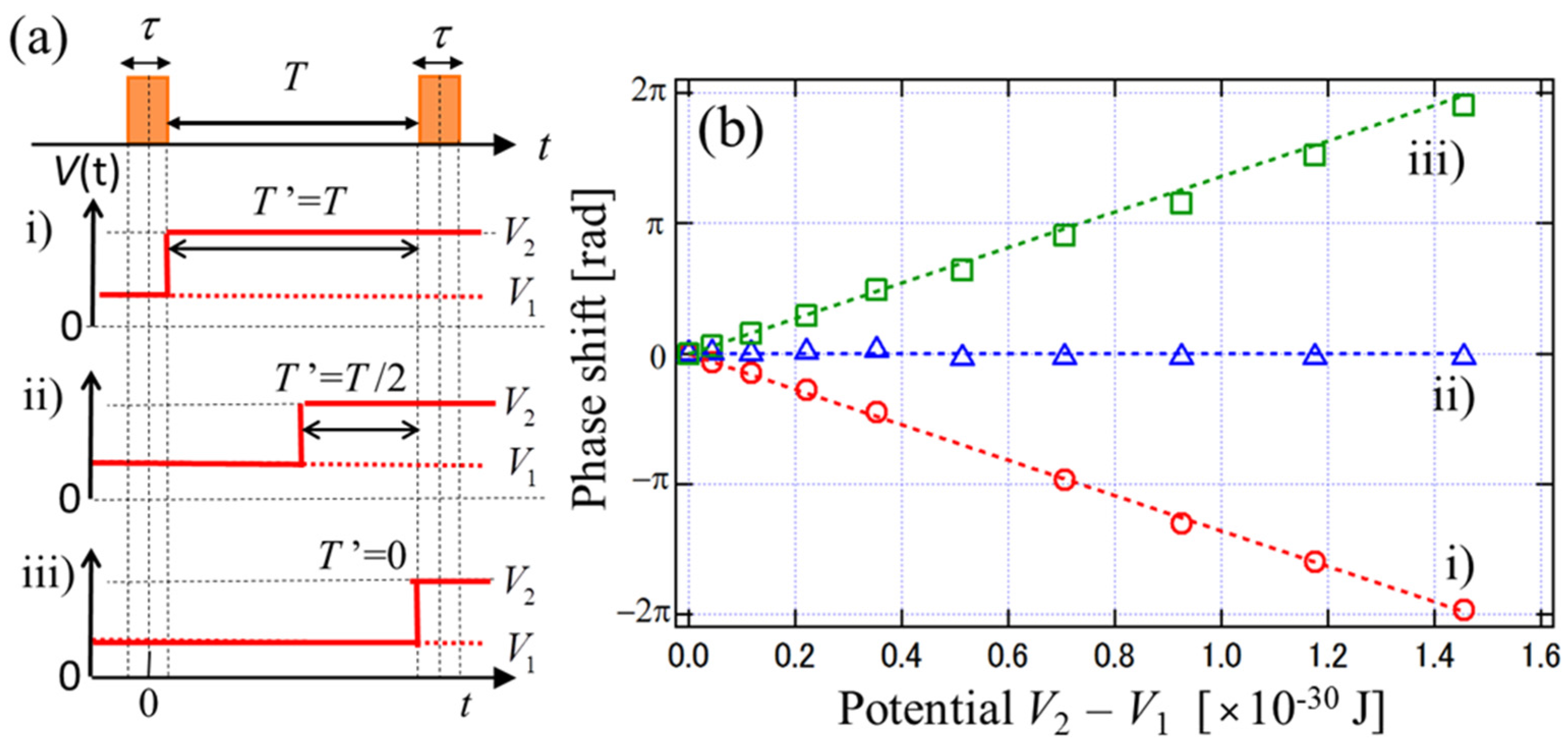Scalar Aharonov–Bohm Phase in Ramsey Atom Interferometry under Time-Varying Potential
Abstract
:1. Introduction
2. Principle
3. Experimental
4. Results and Discussion
4.1. Ramsey Atom Interferometer
4.2. Scalar Aharonov–Bohm Phase
4.3. Ramsey-Type Frequency Standard
5. Conclusions
Acknowledgments
Author Contributions
Conflicts of Interest
References
- Ramsey, N.F. A Molecular beam resonance method with separated oscillating fields. Phys. Rev. 1950, 78, 695–698. [Google Scholar] [CrossRef]
- Bordé, C.J. Atomic interferometry with internal state labelling. Phys. Lett. A 1989, 140, 10–12. [Google Scholar] [CrossRef]
- Cronin, A.D.; Schmiedmayer, J.; Pritchard, D.E. Optics and interferometry with atoms and molecules. Rev. Mod. Phys. 2009, 81, 1051–1130. [Google Scholar] [CrossRef]
- Riehle, F.; Kisters, T.; Witte, A.; Helmcke, J.; Bordé, C.J. Optical Ramsey spectroscopy in a rotating frame: Sagnac effect in a matter-wave interferometer. Phys. Rev. Lett. 1991, 67, 177–180. [Google Scholar] [CrossRef] [PubMed]
- Hudson, J.J.; Kara, D.M.; Smallman, I.J.; Sauer, B.E.; Turbutt, M.R.; Hinds, E.A. Improved measurement of the shape of the electron. Nature 2011, 473, 493–496. [Google Scholar] [CrossRef] [PubMed]
- Heavner, T.P.; Jefferts, S.R.; Donley, E.A.; Shirley, J.H.; Parker, T.E. NIST-F1: Recent improvements and accuracy evaluations. Metrologia 2005, 42, 411–422. [Google Scholar] [CrossRef]
- Aharonov, Y.; Bohm, D. Significance of electromagnetic potentials in the quantum theory. Phys. Rev. 1959, 115, 485–490. [Google Scholar] [CrossRef]
- Allman, B.E.; Cimmino, A.; Opat, G.I.; Klein, A.G.; Kaiser, H.; Werner, S.A. Scalar Aharonov-Bohm experiment with neutrons. Phys. Rev. Lett. 1992, 68, 2409–2412. [Google Scholar] [CrossRef] [PubMed]
- NicChormaic, S.; Miniatura, C.; Gorceix, O.; Lesengo, B.V.; Robert, J.; Feron, S.; Leorent, V.; Reinhardt, J.; Baudon, J.; Rubin, K. Atomic Stern-Gerlach interferences with time-dependent magnetic fields. Phys. Rev. Lett. 1994, 72, 1–4. [Google Scholar] [CrossRef] [PubMed]
- Shinohara, K.; Aoki, T.; Morinaga, A. Scalar Aharonov–Bohm effect for ultracold atoms. Phys. Rev. A 2002, 66, 042106. [Google Scholar] [CrossRef]
- Aoki, T.; Yasuhara, M.; Morinaga, A. Atomic multiple-wave interferometer phase-shifted by the scalar Aharonov–Bohm effect. Phys. Rev. A 2003, 67, 053602. [Google Scholar] [CrossRef]
- Numazaki, K.; Imai, H.; Morinaga, A. Measurement of the second-order Zeeman effect on the sodium clock transition in the weak-magnetic-field region using the scalar Aharonov–Bohm phase. Phys. Rev. A 2010, 81, 032124. [Google Scholar] [CrossRef]
- Riehle, F. Frequency Standards, 1st ed.; Wiley-VCH: Weinheim, Germany, 2004; pp. 192–202. [Google Scholar]
- Moler, K.; Weiss, D.S.; Kasevich, M.; Chu, S. Theoretical analysis of velocity-selective Raman transitions. Phys. Rev. A 1992, 45, 342–348. [Google Scholar] [CrossRef] [PubMed]
- Nakamura, K.; Murakami, M.; Morinaga, A. Dephasing in sodium Ramsey interferometry under a weak inhomogeneous magnetic field. J. Phys. B 2015, 48, 075001. [Google Scholar] [CrossRef]
- Tanaka, H.; Imai, H.; Furuta, K.; Kato, Y.; Tashiro, S.; Abe, M.; Tajima, R. Dual magneto-optical trap of sodium atoms in ground hyperfine F = 1 and F = 2 states. Jpn. J. Appl. Phys. 2007, 46, L492–L494. [Google Scholar] [CrossRef]
- Holloway, J.H.; Racey, R.F. Factors which limit the accuracy of cesium atomic beam frequency standards. In Proceedings of the International Conference on Chronometry, Lausanne, Switzerland, 8–12 June 1964; p. 317.





© 2016 by the authors; licensee MDPI, Basel, Switzerland. This article is an open access article distributed under the terms and conditions of the Creative Commons Attribution (CC-BY) license (http://creativecommons.org/licenses/by/4.0/).
Share and Cite
Morinaga, A.; Murakami, M.; Nakamura, K.; Imai, H. Scalar Aharonov–Bohm Phase in Ramsey Atom Interferometry under Time-Varying Potential. Atoms 2016, 4, 23. https://doi.org/10.3390/atoms4030023
Morinaga A, Murakami M, Nakamura K, Imai H. Scalar Aharonov–Bohm Phase in Ramsey Atom Interferometry under Time-Varying Potential. Atoms. 2016; 4(3):23. https://doi.org/10.3390/atoms4030023
Chicago/Turabian StyleMorinaga, Atsuo, Motoyuki Murakami, Keisuke Nakamura, and Hiromitsu Imai. 2016. "Scalar Aharonov–Bohm Phase in Ramsey Atom Interferometry under Time-Varying Potential" Atoms 4, no. 3: 23. https://doi.org/10.3390/atoms4030023





